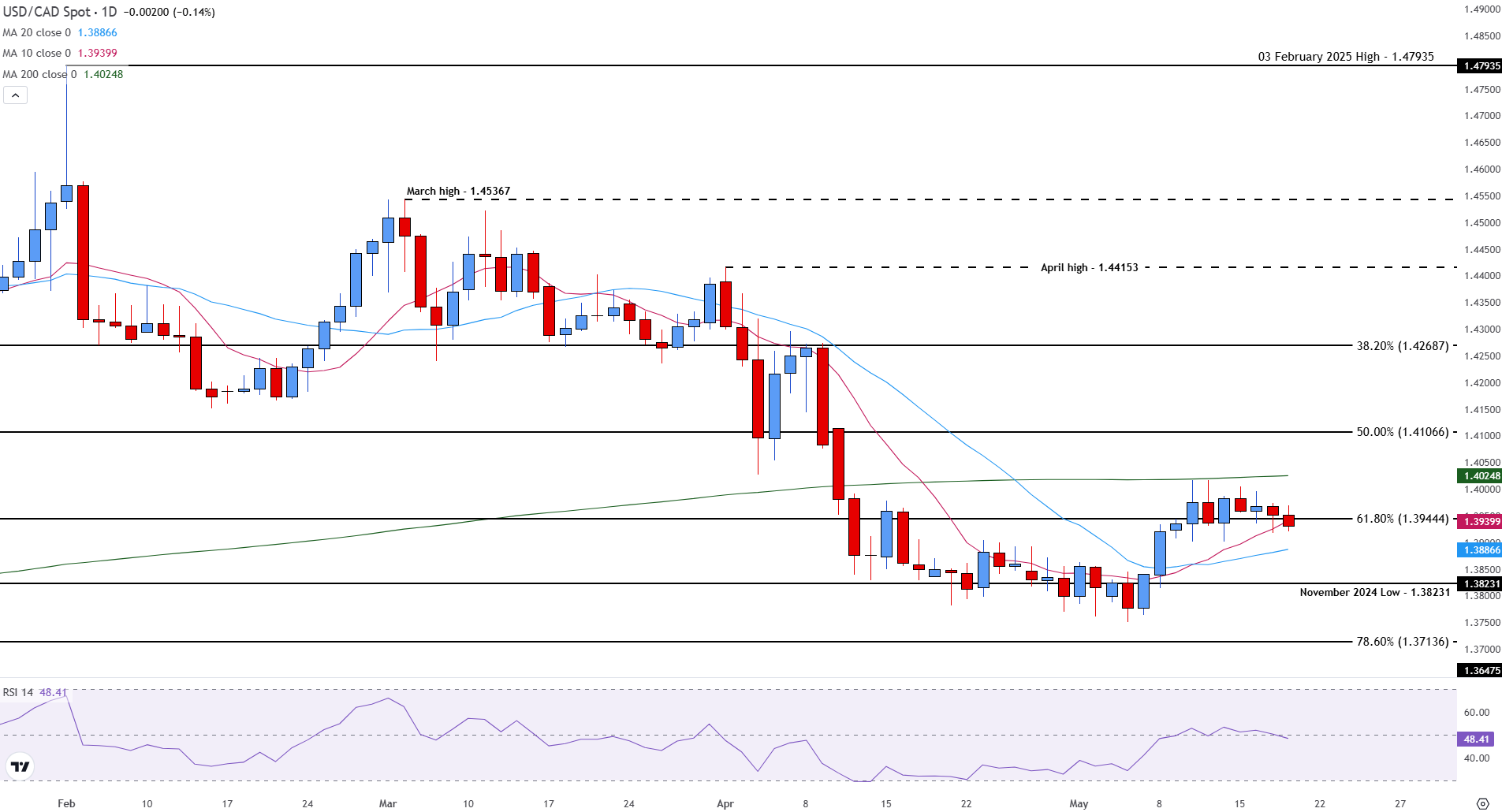- The USD/CAD is maintained within a well -defined range while the markets digest mixed inflation data from Canada.
- The US dollar remains under pressure, with the approach by changing towards the vote of the Fiscal Law on Wednesday.
- The Loonie pair clings to Fibonacci support, with the resistance consolidating in 1,400.
The USD/CAD is being negotiated in a narrow range in the early hours of the US session while the markets react to the latest data from the Canada Consumer Price Index (CPI) of Canada and change their focus towards the vote of the US House of Representatives of the USA on the Fiscal Law Project proposed by President Donald Trump.
At the time of writing, the USD/CAD is being negotiated in a well -defined range, forming around a key level of Fibonacci support around 1,3944, with technical and fundamental factors contributing to the price action.
Mixed Canadian inflation data and US fiscal policy
Canada’s consumer price index (CPI) data published by Canada statistics at 12:30 GMT on Tuesday, presented a mixed inflation image that could influence the next policy movement of the Canada Bank (BOC).
The general CPI (year -on -year (interannual) rose to 1.7%, slightly above the expectations of 1.6%, but drastically below 2.3%in March. In monthly terms, the unexpected IPC decreased 0.1%, failing in the forecasts of a 0.5% increase and slowing down from the 0.3% increase in March. Meanwhile, the underlying (intermensual) IPC, which excludes food and energy, increased 0.5%, exceeding the consensus of 0.2%and rising from the previous 0.1%. The underlying IPC (interannual) rose to 2.5% from 2.2% in March.
The data are critical since they feed the expectations for the decision of BOC rates in June, since the weakest general number reinforces the case for a rate cut, while a firmer underlying inflation can limit the scope of the flexibility of politics and offer support to the Canadian dollar (CAD).
In the United States (USA), the attention has moved towards the vote of Wednesday’s chamber on the “One Big Beautiful Bill” of President Trump, which seeks to extend the tax cuts of 2017 and introduce new relief measures.
Although potentially favorable for short -term growth, the bill generates concerns about long -term debt sustainability, adding pressure on the US dollar.
In addition, the comments of several Fed, Barkin, Musalem, Kugler, Bostic, Daly and Hammack officials are being monitored closely in search of information about the Fed policy position in the midst of the ongoing fiscal and economic uncertainty.
The USD/CAD proves the mobile average support, while the psychological resistance is consolidated in 1,400
The USD/CAD daily graph shows that the torque is consolidating just below the key resistance level in 1,39444, which aligns with the Fibonacci setback level of 61.8% of the Rally from September to February.
The price action is currently trapped between the simple mobile average (SMA) of 10 days in 1,3941 and the 200 -day SMA in 1,4025, pointing out short -term indecision within a broader bearish context.
The relative force index (RSI) is 49.45, reflecting a neutral momentum.
For the upward movement, a decisive breakdown and a closure above 1,39444 they would indicate a bullish potential, with an objective in the 200 -day mobile average and the midpoint of the movement mentioned above in 1,41066.
USD/CAD DAILY GRAPH

An upward continuation could carry the maximum of April in 1,44153 to the focus, suggesting a possible reversal of trend if the bullish momentum is strengthened.
Meanwhile, the inability to overcome 1,39444 could trigger a setback, with immediate support in the minimum of November 1,3823.
A rupture below this level would reinforce the bearish trend, opening the way to a deeper support at the level of 78.6% of Fibonacci about 1.37136 and potentially 1,36475.
The next directional movement depends on whether the bulls can overcome resistance or bassists regain control.
Canadian dollar faqs
The key factors that determine the contribution of the Canadian dollar (CAD) are the level of interest rates set by the Bank of Canada (BOC), the price of oil, the main export product of Canada, the health of its economy, inflation and commercial balance, which is the difference between the value of Canadian exports and that of its imports. Other factors are market confidence, that is, if investors bet on riskier assets (Risk-on) or seek safe assets (Risk-Off), being the positive risk-on CAD. As its largest commercial partner, the health of the US economy is also a key factor that influences the Canadian dollar.
The Canada Bank (BOC) exerts a significant influence on the Canadian dollar by setting the level of interest rates that banks can provide with each other. This influences the level of interest rates for everyone. The main objective of the BOC is to maintain inflation between 1% and 3% by adjusting interest rates to the loss. Relatively high interest rates are usually positive for CAD. The Bank of Canada can also use quantitative relaxation and hardening to influence credit conditions, being the first refusal for CAD and the second positive for CAD.
The price of oil is a key factor that influences the value of the Canadian dollar. Oil is the largest export in Canada, so the price of oil tends to have an immediate impact on the value of the CAD. Generally, if the price of oil rises, the CAD also rises, since the aggregate demand of the currency increases. The opposite occurs if the price of oil drops. The highest prices of oil also tend to give rise to a greater probability of a positive commercial balance, which also supports the CAD.
Although traditionally it has always been considered that inflation is a negative factor for a currency, since it reduces the value of money, the opposite has actually happened in modern times, with the relaxation of cross -border capital controls. Higher inflation usually leads to central banks to raise interest rates, which attracts more capital of world investors who are looking for a lucrative place to save their money. This increases the demand for the local currency, which in the case of Canada is the Canadian dollar.
The published macroeconomic data measure the health of the economy and can have an impact on the Canadian dollar. Indicators such as GDP, manufacturing and services PMIs, employment and consumer confidence surveys can influence the CAD direction. A strong economy is good for the Canadian dollar. Not only attracts more foreign investment, but it can encourage the Bank of Canada to raise interest rates, which translates into a stronger currency. However, if the economic data is weak, the CAD is likely to fall.
Source: Fx Street
I am Joshua Winder, a senior-level journalist and editor at World Stock Market. I specialize in covering news related to the stock market and economic trends. With more than 8 years of experience in this field, I have become an expert in financial reporting.







